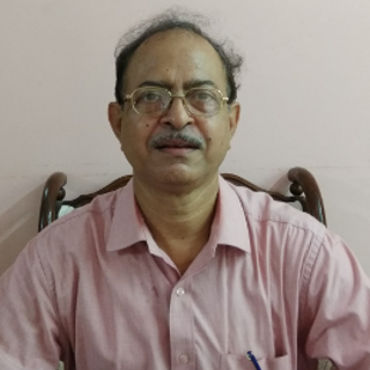
Dr.Bidhan Kumar Bhaumik
Secretary ‘ANURANAN-Science Awareness’ Society
Bio-data:
He joined ‘Uranium Exploration Group’ Atomic Minerals Directorate, Department of Atomic Energy in the year 1983. He joined Health Physics Unit of Variable Energy Cyclotron Centre in 2013 and retired in 2015. After M.Sc he spent three years at Indian Statistical Institute, Kolkata doing research work on Statistical theories of Pattern Recognition under Prof.D.Dutta Majumder.
He processed and interpreted ‘airborne radiometric data’ by statistical significance score analysis and demarcated an area of high uranium potential lying within longitude range of 79 deg 00 min to 79 deg 15 min and latitude range of 16 deg 30 min to 16 deg 45 min which proved three years later to be exactly Lambapur uranium deposit.
He developed a method in 1988 for interpretation of radon data for purposes of recognition of buried uranium ore deposit based on the intercept parameter of linear regression that caught attention of News Media, The Times of India; published a citation under the headline 'New Method to find Uranium'. After 20 years, in 2008, other workers echoed the same conclusion.
He wrote a book titled "Principles of radiometry in radioactive metal exploration" with co-authors : T. Bhattacharya, A.A.P.S.R Acharyulu, D. Sriniwas and M.K. Sandilya in the year 2004. The book was aimed for undergraduate students in earth sciences interested to undertake a course in crustal radioactivity.
Currently, he is Secretary ‘ANURANAN-Science Awareness’ Society, a non-profit Society, which has been planned by the Scientists of Bhabha Centre, Kolkata with an objective to interact and inspire students with a view to making them passionately curious about Science which hopefully makes them much attentive to studies.
Abstract:
Title: Mathematical tool for the interpretation of radiological and other data
Sometimes in geological data consisting of uranium and other elements, it is required to observe the correlation of variables with a view to interpreting the nature of association e.g., uranium is associated with relatively low magnetic field zone of Rohil – Ghateswar deposit at Rajasthan. Low magnetic field is due to the presence of mineral haematite, so uranium should be strongly associated with Fe2O3. It is checked with borehole data, the ‘r’ value between U3O8 and Fe2O3, considering all the samples from ore zones of a borehole, is found to be 0.10, which is not significant. It may be likely that there are different populations present within the data that are very strongly correlated (r ≥ 0.95) but the over-all ‘r’ is poor or meaningless when many populations are treated as one.
With a view to recognising strongly correlated metal associations, the ratio between Fe2O3 and U3O8 have been calculated followed by arranging the samples in ascending order of the ratio. Then first three samples are taken to compute ‘r’ and check whether its value is ≥ 0.95. In case it is true, 4th sample is added and ‘r’ re-computed. The process is continued till ‘r’ remains ≥ 0.95. If ‘r’ is < 0.95 for the first three samples, then start the process from second sample. Four different populations are identified in the samples of one borehole.
Uranium, in a deposit, may also be associated with relatively high magnetic field due to magnetite and in that case U3O8 should be strongly correlated with FeO. We take some data of Jaduguda borehole series and there is very poor correlation between FeO and U3O8 (r = 0.42) but could identify a group when we take Fe(II) vs U in the similar way, described above.
B.R.Kerur et al., (2010) did radioactivity measurements in the granites of North Karnataka lying within long linear belt of latitude range 15 degree – 17 degree and longitude range 76 degree – 77.5 degree. The igneous rocks of granitic composition are enriched in uranium and thorium. The activity concentration (Bq/kg) of U and Th in samples show a correlation of 0.79 which further shows that geochemical coherency is maintained. Using the above mathematical procedure, taking Th/U ratio, it is further classified for interpretation. Larsen and Gottfried (1960), in their samples, observed that a Th/U ratio is larger with increasing complexity of magmatic differentiation.
